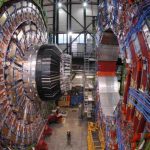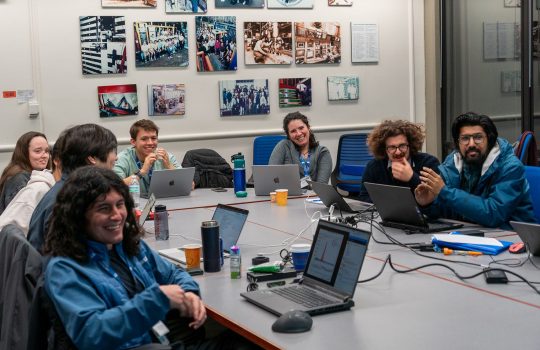Fermilab is developing and testing a revolutionary particle detector concept, one that will enable the CMS detector at CERN’s Large Hadron Collider to handle 10 times the number of particle collisions currently being produced at the European machine — a virtual avalanche. This upgrade will make the LHC the world’s highest-energy proton smasher in the next decades.
At the LHC, two beams of protons are accelerated to nearly the speed of light around the collider’s 18-mile ring in opposite directions, colliding inside one of four detectors, including one called CMS. The protons smash together in the detector’s core, producing a plethora of subatomic particles that fly off in all directions.
The detector — a gigantic, barrel-shaped device that could surround a whale if the instrument were hollow — is packed with layers of detectors that surround the collision site. Think of it as a superhigh-tech onion — a 14,000-ton onion equipped with billions of sensors in its core, buried 100 meters underground. These layers collect data from the particles emerging from the collisions, tracking their paths as they shoot away from the center.
Higher luminosity for the Higgs
In the late 2020s, CERN will turn up the LHC’s beam luminosity, or the number of protons packed into its beams, resulting in showers of even more particles. This increased abundance will give scientists more opportunities to reveal new particles and processes, helping us refine our understanding of how the universe works.
The CMS and ATLAS co-discovered the Higgs boson in 2012, a discovery that led to a Nobel Prize. Now, both experiments are working to learn more about the Higgs and how it behaves — and in the process to maybe reveal something unexpected.
“There’s the possibility of not only making very precise measurements of phenomena that will allow us to test our assumptions about the Standard Model, but also gaining an increased scope for new physics that might be just beyond where we’re reaching now,” said Ron Lipton, a Fermilab scientist on the CMS experiment who is coordinating the detector project at national level.
Of course, the LHC’s high luminosity won’t do much good if the detector isn’t equipped to handle it.
To take advantage of the more prolific collisions — the LHC will produce 40 million particle beam collisions every second — Fermilab scientists and engineers partnered with other CMS collaborators on a new design for components of the CMS detector, enabling it to respond more quickly to the expected particle fusillade. And these components lie at the heart of CMS.
Some of the CMS detector’s most valuable players in detecting and tracking particles are instruments nestled among its the innermost layers. The devices are called tracking modules.
Tracking modules are positioned in shells around the collision site, so they catch most particles flying away from it as they pass through consecutive layers. Together, the modules reconstruct the particles’ trajectories from individual position measurements.
Each module is about the size of your hand and made of two thin, flat silicon layers that lie on top of each other, separated by a few millimeters — a slim, silicon sandwich. Both the silicon layers and their attached chips are made of lightweight material, so they have negligible influence on the path of particles passing through them. Although delicate in appearance, they are durable enough to stand up to the particles bombarding them.
Each silicon layer is made of pixels like those in a digital camera’s sensor. They create refined 3-D images of a particle’s path with lightning-fast shutter speed. About 13,000 new modules in the tracker will together be made of nearly 30 times as many pixels as the current CMS setup, for a total of almost 300 million pixels. Just as with your camera, more and smaller pixels lead to more distinct images. (The average digital camera has around 12 million pixels.)
The modules’ design is also highly innovative: A particle first passes through one silicon sensor, and then the other, mere millimeters away. A single readout chip correlates both sensors’ measurements, selecting signals from only the most energetic particles for further analysis.
The demand on these chips, processing data 40 million times per second — nearly 1 million times higher than in an LCD TV monitor — has never been higher. The boost in processing speed enables CMS to capture and store many more particle collision images at once.
“These are very complex modules to build compared to previous experiments — they’re a novel design, and they will enable CMS to exploit the discovery potential of the machine,” said Fermilab scientist Anadi Canepa.
These intelligent modules simultaneously process and sift through the overwhelming amount of data, singling out interesting events — such as the production of a Higgs boson or supersymmetric particle — close to the collision site rather than processing it from afar, a situation that clogs the pipes with data, so to speak.
“The more collisions you manage to store, the higher the probability that you’ll see a very rare event happen — the kind that scientists see only once in billions of collisions,” Canepa said.
The high-luminosity LHC
The upcoming high-luminosity run will be the LHC’s longest yet. By the end, in the mid-2030s, the LHC will have collected 120 times more data than any previous run.
More data also mean more accurate measurements of particle properties, such as the different ways a particle can decay. This is especially important for rare particles whose behavior has yet to be fully explored, such as the Higgs boson.
“We want to improve our knowledge of the Higgs boson, so we need a lot of data, because the more data you have, the better your precision for a given measurement,” Canepa said.
Fermilab is currently prototyping the tracking modules. Scientists, engineers and technicians have first built small models, called minimodules, similar to those they will eventually install in the detector, and run them through a test beam to make sure they are durable enough to stand up to the LHC’s future high luminosity. They have also just completed the assembly of the first U.S. full-size, functional module. Collaborators at Brown, Princeton and Rutgers universities are building the modules as well, in addition to other detector components.
Fermilab plans to build roughly 3,000 modules, and the installation of the modules and other components is scheduled to begin at CERN in the mid-2020s.
The tracking modules are the first in a series of CMS upgrades in which Fermilab plays a key role. The lab will also be responsible for building components that measure the energy of the postcollision particles, detect their arrival times and help single out significant events from the ordinary ones.
They will be ready in time for the LHC’s high-luminosity beams, which we can expect to speed around that 18-mile ring in 2026.




